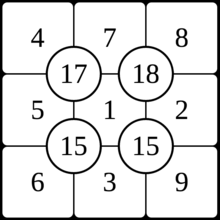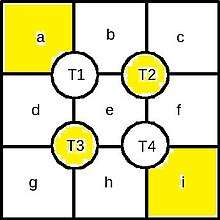Sujiko
Sujiko is a logic-based, combinatorial number-placement puzzle created by Jai Gomer of Kobayaashi Studios.[1]

The puzzle takes place on a 3x3 grid with four circled number clues at the centre of each quadrant which indicate the sum of the four numbers in that quadrant. The numbers 1-9 must be placed in the grid, in accordance with the circled clues, to complete the puzzle.
Sujiko is featured in UK newspapers including The Times, The Telegraph, and The Sun.[2]
Sujiko properties

The puzzle has a mathematical property, often ignored by puzzle setters, that can sometimes make supposedly-difficult examples somewhat trivial, as follows:
The sum of two diagonally-opposite CORNER numbers and the two TOTALS on the OTHER diagonal (e.g. the yellow numbers in the second image) is always equal to the MIDDLE number, plus 45.
In letters:
(a + i) + (T2 + T3) [ = P, say]
== (c + g) + (T1 + T4) [ '''== Q''', say]
= '''e''' + 45
E.g. from the completed Sujiko Puzzle shown,
(4 + 9) + (18 + 15) = 46
(8 + 6) + (17 + 15) = 46
And 1 + 45 = 46
Proof, for P
T2 = b + c + e + f, by definition
T3 = d + e + g + h, by definition
So P = (a + i) + (T2 + T3) can be rewritten as
P = (a + i) + (b + c + e + f) + (d + e + g + h)
Or, rearranging,
P = (a + b + c + d + e + f + g + h + i) + e
But (a + ... + i) is just the sum of all the numbers 1 to 9 in some order, i.e. 45
So P = 45 + e
Q is trivially obvious, by symmetry (or can be similarly proved from first principles).
References
- ↑ "Sujiko". Puzzler. Retrieved 2016-07-22.
- ↑ "Kobayaashi". www.sujiko.co.uk. Retrieved 2016-07-22.